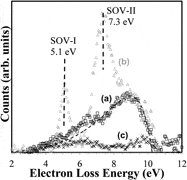Crossref Citations
This article has been cited by the following publications. This list is generated based on data provided by
Crossref.
Koh, Donghyi
Yum, Jung-Hwan
Banerjee, Sanjay K.
Hudnall, Todd W.
Bielawski, Christopher
Lanford, William A.
French, Benjamin L.
French, Marc
Henry, Patrick
Li, Han
Kuhn, Markus
and
King, Sean W.
2014.
Investigation of atomic layer deposited beryllium oxide material properties for high-k dielectric applications.
Journal of Vacuum Science & Technology B, Nanotechnology and Microelectronics: Materials, Processing, Measurement, and Phenomena,
Vol. 32,
Issue. 3,
King, Sean W.
Brockman, Justin
French, Marc
Jaehnig, Milt
Kuhn, Markus
and
French, Benjamin
2014.
Valence and conduction band offsets at low-k a-SiOxCy:H/a-SiCxNy:H interfaces.
Journal of Applied Physics,
Vol. 116,
Issue. 11,
Alimardani, Nasir
King, Sean W.
French, Benjamin L.
Tan, Cheng
Lampert, Benjamin P.
and
Conley, John F.
2014.
Investigation of the impact of insulator material on the performance of dissimilar electrode metal-insulator-metal diodes.
Journal of Applied Physics,
Vol. 116,
Issue. 2,
King, Sean W.
Davis, Robert F.
and
Nemanich, Robert J.
2014.
Gas source molecular beam epitaxy of scandium nitride on silicon carbide and gallium nitride surfaces.
Journal of Vacuum Science & Technology A: Vacuum, Surfaces, and Films,
Vol. 32,
Issue. 6,
Pomorski, T. A.
Bittel, B. C.
Lenahan, P. M.
Mays, E.
Ege, C.
Bielefeld, J.
Michalak, D.
and
King, S. W.
2014.
Defect structure and electronic properties of SiOC:H films used for back end of line dielectrics.
Journal of Applied Physics,
Vol. 115,
Issue. 23,
Nichols, M. T.
Li, W.
Pei, D.
Antonelli, G. A.
Lin, Q.
Banna, S.
Nishi, Y.
and
Shohet, J. L.
2014.
Measurement of bandgap energies in low-k organosilicates.
Journal of Applied Physics,
Vol. 115,
Issue. 9,
Lu, Qifeng
Zhao, Chun
Mu, Yifei
Zhao, Ce
Taylor, Stephen
and
Chalker, Paul
2015.
Hysteresis in Lanthanide Zirconium Oxides Observed Using a Pulse CV Technique and including the Effect of High Temperature Annealing.
Materials,
Vol. 8,
Issue. 8,
p.
4829.
Vos, M.
Marmitt, G. G.
Finkelstein, Y.
and
Moreh, R.
2015.
Determining the band gap and mean kinetic energy of atoms from reflection electron energy loss spectra.
The Journal of Chemical Physics,
Vol. 143,
Issue. 10,
Vos, Maarten
King, Sean W.
and
French, Benjamin L.
2016.
Measurement of the band gap by reflection electron energy loss spectroscopy.
Journal of Electron Spectroscopy and Related Phenomena,
Vol. 212,
Issue. ,
p.
74.
Pei, D.
Xue, P.
Li, W.
Guo, X.
Lin, Y. H.
Fung, H. S.
Chen, C. C.
Nishi, Y.
and
Shohet, J. L.
2016.
The effect of vacuum ultraviolet irradiation on the time-dependent dielectric breakdown of organosilicate dielectrics.
Applied Physics Letters,
Vol. 109,
Issue. 12,
Mutch, Michael J.
Pomorski, Thomas
Bittel, Brad C.
Cochrane, Corey J.
Lenahan, Patrick M.
Liu, Xin
Nemanich, Robert J.
Brockman, Justin
French, Marc
Kuhn, Markus
French, Benjamin
and
King, Sean W.
2016.
Band diagram for low-k/Cu interconnects: The starting point for understanding back-end-of-line (BEOL) electrical reliability.
Microelectronics Reliability,
Vol. 63,
Issue. ,
p.
201.
Zizka, J.
King, S.
Every, A. G.
and
Sooryakumar, R.
2016.
Mechanical properties of low- and high-k dielectric thin films: A surface Brillouin light scattering study.
Journal of Applied Physics,
Vol. 119,
Issue. 14,
Dhungana, Shailesh
Nordell, Bradley J.
Caruso, Anthony N.
Paquette, Michelle M.
Lanford, William A.
Scharfenberger, Kris
Jacob, Danya
and
King, Sean W.
2016.
Combinatorial survey of fluorinated plasma etching in the silicon-oxygen-carbon-nitrogen-hydrogen system.
Journal of Vacuum Science & Technology A: Vacuum, Surfaces, and Films,
Vol. 34,
Issue. 6,
Hays, David C.
Gila, B. P.
Pearton, S. J.
and
Ren, F.
2016.
Valence and Conduction Band Offsets in Sputtered LaAlO3/InGaZnO4Heterostructures.
ECS Journal of Solid State Science and Technology,
Vol. 5,
Issue. 12,
p.
P680.
Gaskins, John T.
Hopkins, Patrick E.
Merrill, Devin R.
Bauers, Sage R.
Hadland, Erik
Johnson, David C.
Koh, Donghyi
Yum, Jung Hwan
Banerjee, Sanjay
Nordell, Bradley J.
Paquette, Michelle M.
Caruso, Anthony N.
Lanford, William A.
Henry, Patrick
Ross, Liza
Li, Han
Li, Liyi
French, Marc
Rudolph, Antonio M.
and
King, Sean W.
2017.
Review—Investigation and Review of the Thermal, Mechanical, Electrical, Optical, and Structural Properties of Atomic Layer Deposited High-kDielectrics: Beryllium Oxide, Aluminum Oxide, Hafnium Oxide, and Aluminum Nitride.
ECS Journal of Solid State Science and Technology,
Vol. 6,
Issue. 10,
p.
N189.
Lu, Qifeng
Zhao, Ce Zhou
Zhao, Chun
Taylor, Steve
and
Chalker, Paul R.
2017.
Investigation of anomalous capacitance-voltage behavior caused by interface dipoles and the effect of post-metal-annealing.
Vol. 1880,
Issue. ,
p.
050001.
Hays, David C.
Gila, B. P.
Pearton, S. J.
and
Ren, F.
2017.
Energy band offsets of dielectrics on InGaZnO4.
Applied Physics Reviews,
Vol. 4,
Issue. 2,
Dhungana, Shailesh
Nguyen, Thuong D.
Nordell, Bradley J.
Caruso, Anthony N.
Paquette, Michelle M.
Chollon, Georges
Lanford, William A.
Scharfenberger, Kris
Jacob, Danya
and
King, Sean W.
2017.
Boron and high-k dielectrics: Possible fourth etch stop colors for multipattern optical lithography processing.
Journal of Vacuum Science & Technology A: Vacuum, Surfaces, and Films,
Vol. 35,
Issue. 2,
Scott, Ethan A.
Gaskins, John T.
King, Sean W.
and
Hopkins, Patrick E.
2018.
Thermal conductivity and thermal boundary resistance of atomic layer deposited high-k dielectric aluminum oxide, hafnium oxide, and titanium oxide thin films on silicon.
APL Materials,
Vol. 6,
Issue. 5,
Koh, Donghyi
Banerjee, Sanjay K.
Locke, Chris
Saddow, Stephen E.
Brockman, Justin
Kuhn, Markus
and
King, Sean W.
2019.
Valence and conduction band offsets at beryllium oxide interfaces with silicon carbide and III-V nitrides.
Journal of Vacuum Science & Technology B, Nanotechnology and Microelectronics: Materials, Processing, Measurement, and Phenomena,
Vol. 37,
Issue. 4,


